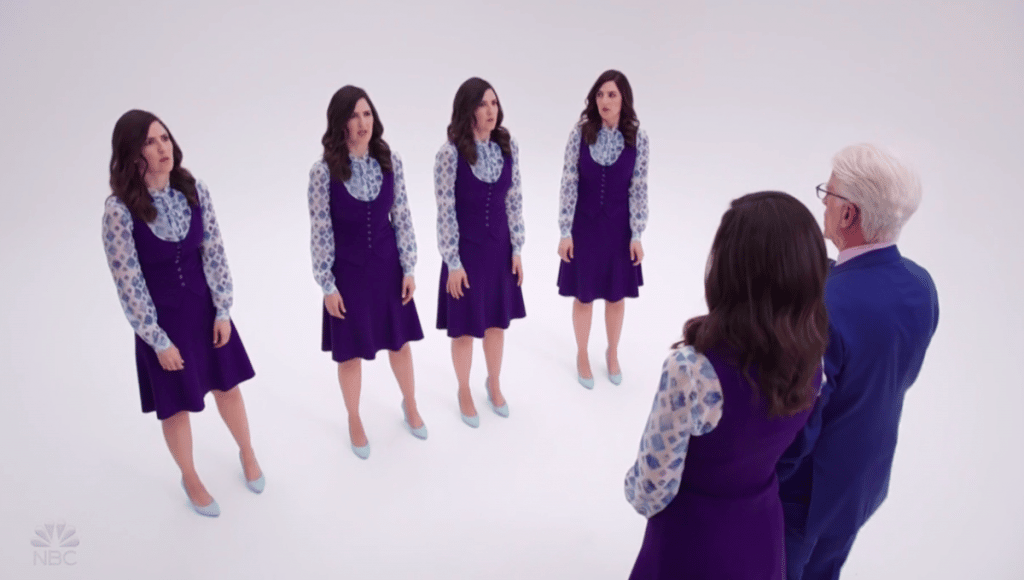We’re in the architect’s office at the end of “Pandemonium,” about to embark on yet another rollercoaster of a plot hook. Walking-talking-database Janet (D’Arcy Carden), more human than ever after a few hundred reboots and some quality time on Earth, has just given Eleanor (Kristen Bell) some much-needed advice.
“You know,” remarks Eleanor, “for a robot, you make a really good girl friend.”
Janet smiles. “I’m one out of three of those things. But thank you.”
Janet has emerged as something of a wild card in The Good Place’s ensemble. Since starting out as a glorified Siri, she’s developed increased sentience, complex emotions, and the ability to create more “people” like her. But there’s one thing that hasn’t changed about her: her sense of her own gender. Or, to be more accurate, her lack of gender.
While showrunner Mike Schur seemed much more invested in the question of what Janet isn’t rather than the reality of what she is when he created her, viewers have mapped a nonbinary identity onto Janet since the character’s first utterance of her “I’m not a girl” catchphrase (something Carden has also acknowledged). This assignment of identity is more than simple wish fulfillment, but a response to the explicit queer-coding that such a catchphrase entails. Janet is a femme-presenting* character who uses she/her pronouns and is played by a cis woman,** yet who insists at every opportunity (and with great confidence) that she isn’t a girl – presumably, she isn’t any gender at all. Janet, as current gender discourse understands her, is nonbinary.

Viewers – especially trans and nonbinary viewers – have subsequently embraced Janet en masse as a shining example of casual nonbinary representation. I’m included in that number, and I have the sticker on my water bottle to prove it. But it’s not enough to simply include a trans or nonbinary person in your media; diversity does not equal inclusion.*** Instead, if we’re going to embrace Janet as nonbinary (which I believe we should), we need to face the full ramifications of how her gender is treated on the show. When you dig beneath the surface of Janet, you start to find some alarming things – and, no, I’m not talking about the time knife.
In the moment I pointed out above – indeed, in every “I’m not a girl” moment – Janet’s correction of other characters’ assumption of her gender is played, at some level, for laughs. It’s funny, the show tells us, that Janet is so emphatically not-a-girl, and that characters keep calling her one in various contexts. The assumed humor in these moments stems from a fundamental dissonance: Janet’s not-a-girl-ness is contrasted by her being so convincingly girly, from perfectly curled hair to neat blouse-and-skirt combos.
Janet, as current gender discourse understands her, is nonbinary.
But this type of humor depends on the mockery and ultimate erasure of Janet’s nonbinary coding. Janet’s existence as an ungendered femme who uses she/her pronouns both elevates and condemns her as a character, both in the real world and in-universe. Her continued reminders that she is not a girl seem to fall on deaf ears, from Eleanor thanking her for advice to once-husband Jason (Manny Jacinto) falling in love with her. Her gendered reality is ignored even by her closest friends in favor of simplicity and, on a metatextual level, in favor of a joke at the expense of nonbinary people.
This erasure is compounded by the further coding of a genderqueer character as inhuman – in this case literally. Her not-human-ness is linked intrinsically to her not-girl-ness: Janets do not conform to human gender systems precisely because they are not humans. This trope of the dehumanized or robotic genderqueer is actually pretty common, from Adventure Time’s anthropomorphic game console BMO to the Billions’ hypersmart, monotoned Taylor Mason. But the example that most closely aligns with Janet’s particular coding is probably Steven Universe.

Steven Universe is an animated children’s show about sentient alien gemstones, and show creator Rebecca Sugar has been extremely open about the fact that the show’s gem characters are all nonbinary femmes. Every gem uses she/her pronouns, and many of them are extremely femme-presenting. In other words, this show codes its nonbinary characters in the same ways that Janet is coded. But unlike Janet, the gems’ gender is never questioned. Furthermore, while the nonbinary nature of gems is certainly related to their status as non-humans, the (mostly) human fusion Stevonnie is also explicitly nonbinary. In other words, Steven Universe elevates and humanizes its genderqueer characters, while Janet’s identities remain throwaway lines and catchphrases.
I’m not trying to say that Janet is a wasted grab at diversity, or even that her existence is capital-P Problematic. Janet’s existence does a lot of good for nonbinary viewers, because here’s the thing: there are real humans like Janet out there. Nonbinary identity includes a lot of different things, and one of those things is a person assigned female at birth who uses she/her pronouns, but still isn’t a girl. You may know someone who fits this description. I do. And these people deserve to be represented just as much as people who are (big quotation marks here) “visibly” trans and genderqueer.
But it’s not enough to give lip-service to
*Vocab time! Femme-presenting: displaying the appearance and mannerisms of traditional femininity.
**Cis woman: a person who was assigned female at birth and also identifies as female.
***If it was, progress would have culminated with the success of Rent, but instead we’re still hiring playwrights who believe Angel is a cis man and casting cis men to play her and – *sigh* just forget it.